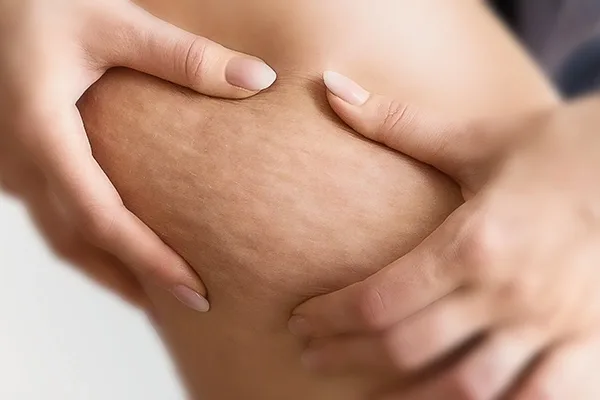What is IV Therapy and How Can It Benefit You?
What is IV therapy? A method to deliver fluids, medications, and nutrients directly into the bloodstream for fast results.
Key Benefits: Rapid hydration, nutritional support, effective medication delivery.
Common Uses: Treating dehydration and infections, supporting wellness (e.g., energy, skin health).
Potential Risks: Infection, fluid overload, allergic reactions.
What to Expect: Consultation, catheter insertion, infusion, monitoring.
Welcome to The Complete Guide to IV Therapy: Uses, Benefits, and What to Expect! In today’s fast-paced world, health and wellness are at the forefront of our minds. As we strive to maintain our well-being, innovative solutions like IV therapy have emerged as powerful tools for achieving optimal health. This guide aims to provide you with a thorough understanding of IV therapy, a method that delivers essential nutrients, fluids, and medications directly into the bloodstream, ensuring immediate absorption and maximum effectiveness.
Intravenous (IV) therapy has emerged as a pivotal element in modern medical and wellness practices, offering a range of treatments that cater to various health needs. In our series of articles, we have delved into multiple facets of IV therapy, exploring its applications, benefits, and the science behind its effectiveness. From hydration and nutrient delivery to skin rejuvenation and weight loss, IV therapy is a versatile solution that meets the demands of today’s health-conscious individuals.

As we navigate through the intricacies of this therapeutic approach, we aim to provide readers with valuable insights into how IV therapy can enhance overall health and well-being. We have covered essential topics such as the sensations experienced during IV insertion, the process of IV therapy, its role in skin rejuvenation, and the potential anti-aging effects of vitamin infusions. Each article presents a unique perspective, shedding light on the advantages of IV treatments while addressing common concerns and misconceptions.
Before we dive deeper into the details of IV therapy, let’s take a moment to recap the key insights from our previous articles. Whether you’re considering IV therapy for personal wellness, aesthetic improvements, or medical needs, our comprehensive exploration serves as a reliable resource.
For those interested in experiencing the benefits of IV therapy firsthand, we invite you to visit Elegant Hoopoe website, where you can explore a wide range of IV services available at our branches in Dubai, Jumeirah, and Abu Dhabi. Our team of skilled doctors and state-of-the-art equipment ensure that you receive the highest quality of care. Join us as we unpack the multifaceted world of IV therapy and discover how it can support your health journey.
IV Drip Therapy Explained:
IV drip therapy is a crucial medical technique for delivering fluids, medications, and nutrients directly into the bloodstream. It is highly versatile, serving roles from emergency interventions in surgeries and intensive care to routine treatments for chronic conditions. The immediacy and controlled delivery make it invaluable across hospital departments.
How IV Drips Work:
An IV drip involves inserting a catheter into a vein, usually in the arm, connected to an IV bag via tubing. The bag contains solutions like saline, medications, or nutrients, which are administered at a controlled rate. This method bypasses the digestive system for rapid effects, making it essential in critical care.
Common Hospital Uses:
- Rehydration: Treats dehydration from illnesses like severe fever or vomiting.
- Medication Delivery: Provides fast-acting administration of drugs, including antibiotics and pain relief.
- Parenteral Nutrition: Supplies nutrients directly for patients unable to eat.
- Electrolyte Balancing: Corrects imbalances in patients with conditions like kidney disease.
- Blood Transfusions: Used in cases of significant blood loss.
- Surgery Support: Maintains hydration and administers necessary medications.
IV Drips Benefits:
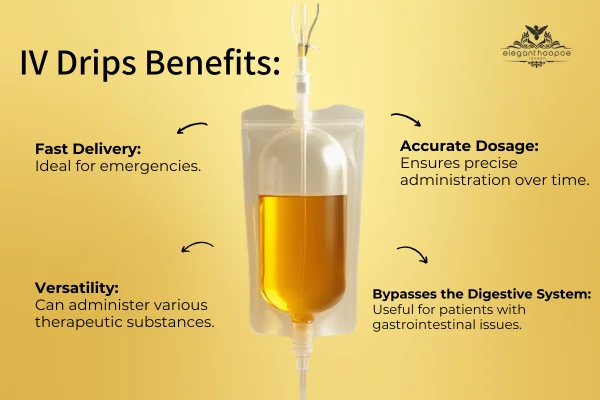
- Fast Delivery: Ideal for emergencies.
- Accurate Dosage: Ensures precise administration over time.
- Bypasses the Digestive System: Useful for patients with gastrointestinal issues.
- Versatility: Can administer various therapeutic substances.
Types of IV Drips:
- Peripheral IV Lines: Short-term use.
- Central Lines: Long-term treatments.
- PICC Lines: For extended therapies.
- Midline Catheters: Intermediate-duration treatments.
Potential Risks:
While generally safe, risks include infection, phlebitis (vein inflammation), air embolism, and infiltration (fluid leakage into surrounding tissues).
For further exploration, consult the related article for additional insights and recommendations:What is IV drip
Understanding the Basics of IV Therapy
Intravenous (IV) therapy is a medical technique that delivers fluids, medications, and nutrients directly into the bloodstream. The term “IV” stands for “intravenous,” meaning “within a vein.” This method ensures rapid and effective treatment by bypassing the digestive system, making it especially valuable in emergencies, surgeries, or when oral intake is not feasible.

What is an IV?
An IV involves inserting a needle or catheter into a vein, typically in the arm or hand, to administer therapeutic agents such as fluids, medications, or nutrients. It’s commonly used in hospitals, clinics, and wellness centers to treat conditions like dehydration, infections, and nutrient deficiencies. In wellness practices, IV therapy supports hydration, delivers vitamins, and aids in recovery.
IV Meaning
Derived from Latin roots “intra” (within) and “vena” (vein), the term “intravenous” emphasizes the method of delivery directly into the veins. This approach revolutionizes patient care by providing precise control over treatment delivery.
What are IV Fluids?
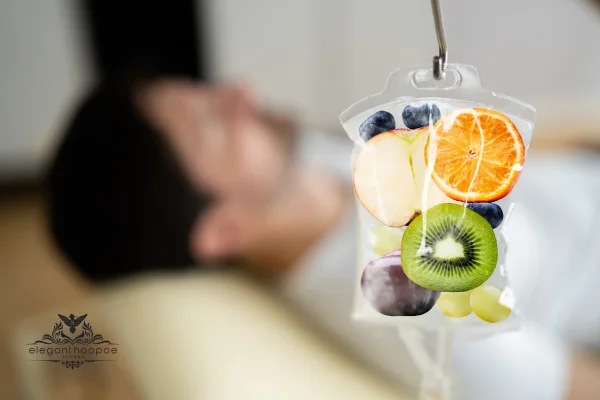
IV fluids are sterile liquids used to maintain fluid balance, replenish electrolytes, or provide nutrients. Types of IV fluids include saline, dextrose, or complex solutions with vitamins and minerals, tailored to a patient’s specific needs based on their medical condition.
Types of IV Solutions
- Isotonic Solutions: Examples include normal saline and lactated Ringer’s solution, which are used for hydration and electrolyte replacement.
- Hypotonic Solutions: Such as half-normal saline, help treat cellular dehydration.
- Hypertonic Solutions: Examples include dextrose 5% in saline and 3% saline, which draw fluids into the bloodstream and is often used in critical care.
IV Line and Administration
An IV line is the flexible tubing connecting the IV bag to the catheter in the vein. The IV line can be placed in smaller peripheral veins for short-term use or in larger central veins near the heart for long-term or complex treatments. Proper placement and maintenance are crucial to avoid complications like infections.
How Does an IV Work?
An IV setup comprises:
- IV Bag: Contains the fluids or medications to be administered.
- IV Tubing: Regulates fluid flow.
- Catheter: Allows direct fluid delivery into the vein.
- Drip Chamber and Roller Clamp: Help control the flow rate and prevent air from entering the bloodstream.
Uses of IV Therapy
IV therapy is versatile, serving diverse medical and wellness needs, including:
- Rehydration: For dehydration due to illness, exercise, or heat.
- Medication Delivery: For faster therapeutic effects.
- Nutrient Supplementation: For patients unable to absorb nutrients orally.
- Blood Transfusions and Electrolyte Replacement: Especially in emergencies.
Types of IVs
- Peripheral IV Lines: For short-term treatments.
- Central IV Lines: For long-term or intensive therapies.
- PICC Lines: For prolonged treatments like chemotherapy.
- Midline Catheters: Suitable for intermediate-duration therapies.
- IV Drips vs. IV Infusions: Drips provide continuous delivery, while infusions can be given intermittently.
Benefits of IV Therapy
- Rapid Action: Direct delivery to the bloodstream allows for immediate effects.
- Precision: Enables accurate control over dosage and timing.
- Versatility: Can be tailored to individual patient needs.
- Enhanced Hydration and Nutrient Delivery: Vital for recovery.
- Improved Patient Comfort: Ideal for those unable to take medications orally.
IV Therapy Potential Risks
- Infection: Can occur at the insertion site.
- Phlebitis: Inflammation of the vein.
- Fluid Overload: If too much fluid is administered.
- Air Embolism: Risk of air entering the IV line.
For more comprehensive advice, refer to: What is an IV
Vitamin IV Therapy
Vitamin IV Therapy is rapidly gaining popularity in the wellness industry due to its ability to deliver vitamins and nutrients directly into the bloodstream, bypassing the digestive system for faster absorption. This therapy is used in clinics, spas, and wellness centers to enhance health, boost energy levels, and address nutrient deficiencies.
What is Vitamin IV Therapy?
Vitamin IV therapy, also known as vitamin infusion therapy, administers vitamins and minerals through an intravenous drip, ensuring higher potency and quicker delivery compared to oral supplements. Infusions can be customized based on individual health needs and may target issues like fatigue, dehydration, immune support, or skin rejuvenation.
How Does It Work?
The treatment typically lasts 30-60 minutes and is performed by licensed healthcare professionals. Nutrients are infused directly into the bloodstream, leading to higher serum concentrations and optimal absorption, especially beneficial for those with malabsorption issues or urgent health needs.
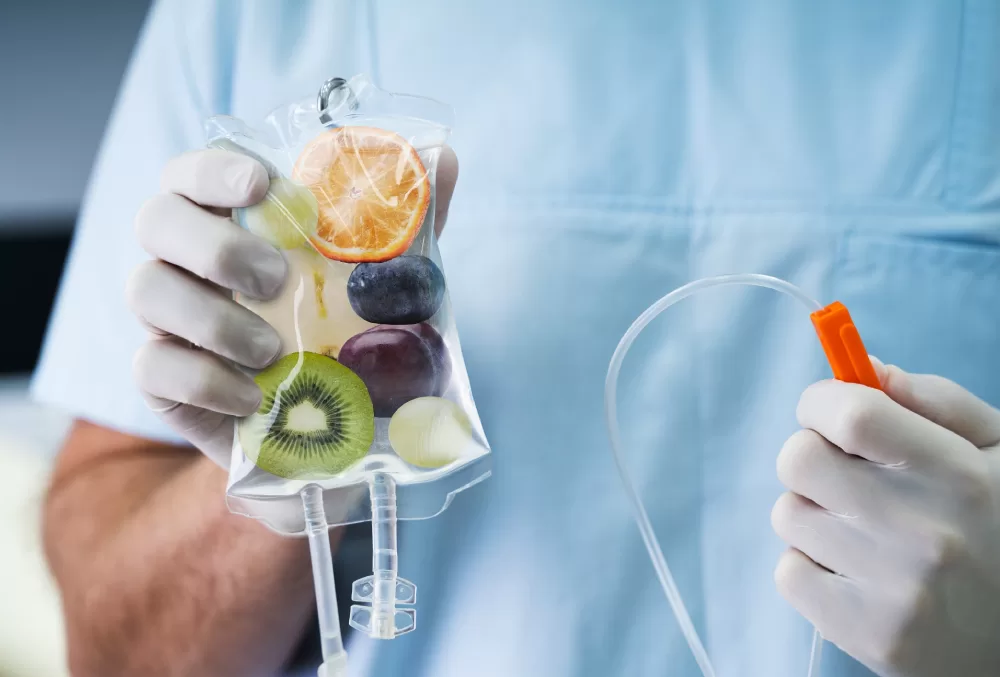
Popular Vitamins in IV Therapy:
- Vitamin C IV Drip: Supports immune function, collagen production, and skin health, while also reducing fatigue.
- Vitamin B12 IV Drip: Enhances energy levels, supports the nervous system, and aids in mood improvement.
- Glutathione IV Drip: Acts as a powerful antioxidant, promoting detoxification and skin brightening.
Benefits of Vitamin IV Therapy:
- Faster Absorption: Rapid nutrient uptake, beneficial for athletes or those needing quick health boosts.
- Customized Treatments: Tailored infusions based on individual health requirements.
- Enhanced Immune Support: High-dose Vitamin C boosts immunity, particularly during flu season.
- Hydration and Recovery: Rehydrates the body, useful after illnesses or strenuous activities.
- Improved Skin Appearance: Vitamins like C and Glutathione enhance skin texture and reduce pigmentation.
- Scientific Evidence: Studies support the benefits of IV therapy for conditions like colds, B12 deficiencies, and skin health.
- Risks and Considerations: Potential side effects include infection, vein irritation, and allergic reactions, emphasizing the need for proper administration by trained professionals.
For additional insights and valuable advice, refer to: Vitamin IV drip
5 Alarming Reasons to Avoid Homemade IV Therapy
Homemade IV therapy has gained popularity, but recent research highlights the significant dangers associated with it. A study published in August 2023 examined the death of a 37-year-old woman linked to a homemade IV infusion, underscoring the risks of such practices. Here are five reasons why homemade IV therapy is generally a bad idea:
- Quality of Supplies: Homemade IV therapy often involves sourcing low-quality materials, such as needles and drip bags, which can pose health risks. Untrained individuals may not know how to assess the quality of supplies or ensure proper storage.
- Improper Administration: Inserting a needle requires medical training and experience. Untrained administrators may mistakenly puncture an artery, causing severe complications, including excessive bleeding or death. They might also struggle with managing complications during and after the procedure.
- Monitoring Challenges: Properly monitoring the IV drip rate is crucial, as incorrect volumes can lead to serious complications. Healthcare professionals are trained to adjust and monitor the flow, a skill that is often lacking in homemade setups.
- Adverse Reactions: IV therapy bypasses the digestive system, which is designed to filter out harmful substances. This can lead to unexpected adverse reactions, especially if the nutrients are not correctly tailored to the individual’s health needs.
- Inadequate Aftercare: Post-procedure care is vital for healing and preventing infections. Untrained individuals may neglect proper dressing, monitoring of vital signs, and disposal of equipment, increasing the risk of complications.
Overall, the lack of professional guidance, training, and quality assurance in homemade IV therapy presents significant health risks that far outweigh potential benefits.
For more insights and a detailed discussion, check: IV therapy at home
IV Infusion Therapy: Everything You Need to Know
IV infusion therapy involves delivering fluids, medications, vitamins, or nutrients directly into the bloodstream through a vein, ensuring quicker and more efficient absorption than oral methods. This therapy has a wide range of applications, from medical treatments for chronic conditions and post-surgical recovery to wellness benefits like hydration and nutrient support.
Key Methods:
- IV Drip: Gradually delivers fluids over 30-60 minutes, suitable for rehydration and administering controlled doses of medications.
- IV Push: Injects a concentrated dose directly into the bloodstream in a few minutes, used for immediate effects.
Applications:
Medical Uses:
- Chronic Illness Management: Enhances nutrient uptake for conditions like Crohn’s disease and anemia.
- Post-Surgical Recovery: Addresses dehydration and malnutrition, facilitating faster healing.
- Cancer Treatment Support: Manages dehydration and nutrient deficiencies during chemotherapy.
Wellness Uses:
- Hydration Therapy: Replenishes fluids for athletes and those engaging in strenuous activities.
- Hangover Relief: Quickly rehydrates and alleviates symptoms post-alcohol consumption.
- Immune Boost Therapy: Provides essential vitamins to strengthen immunity during flu seasons.
Comparison with Oral Hydration:
- Absorption Speed: IV is rapid; oral is slower.
- Bioavailability: IV has high nutrient absorption; oral is lower.
- Effectiveness for Severe Cases: IV is better for severe dehydration.
- Medical Emergency Use: IV is common; oral is not suitable.
FAQs:
- Duration: IV sessions typically last 30 minutes to an hour.
- Side Effects: Mild effects include bruising or lightheadedness; severe effects are rare.
- Who Can Receive It: Many can benefit, but medical conditions may necessitate adjustments.
For additional insights and a comprehensive analysis, explore: IV infusion therapy
IV Therapy Side Effects
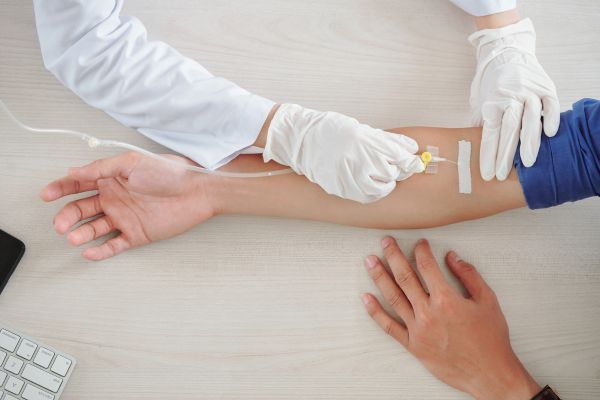
IV therapy, which involves inserting a needle into a vein (usually in the arm), is generally safe but can lead to several side effects at the insertion site:
- Blood Vessel Damage: Insertion can cause minor injuries to blood vessels, leading to discomfort.
- Bleeding and Bruising: Mild bleeding and bruising are common, especially if the vein is missed during insertion.
- Swelling and Inflammation: Leakage from the vein can cause swelling; prolonged IV use may result in phlebitis, characterized by tenderness and redness.
- Hematoma: A localized collection of clotted blood may form, causing discomfort but typically resolves on its own.
- Infection: Poor hygiene can lead to infections at the insertion site, manifesting as redness, warmth, and pus.
Risks and Complications
Though usually minor, serious complications can arise, particularly if not performed by trained professionals:
- Allergic Reactions: Some patients may experience allergies to adhesive tape or medications, potentially leading to skin rashes or breathing difficulties.
- Blood Clots and Air Embolisms: Clots can obstruct blood flow, and air bubbles may cause life-threatening air embolisms.
- Cellulitis and Abscess Formation: Deep infections can result in cellulitis, leading to abscesses if untreated.
- Skin Necrosis: Improper long-term IV use may cause skin cell death, requiring surgical intervention.
- Fluid Overload and Electrolyte Imbalance: Excess fluid can stress the heart and alter electrolyte levels, potentially leading to serious complications.
Side Effects
Vitamin IV therapy bypasses the digestive system but carries risks, including:
- Infection and Inflammation: Nonsterile conditions may lead to infections.
- Vitamin Toxicity: High doses of vitamins (like A and D) can cause serious health issues.
- Electrolyte Imbalance: Imbalances can lead to dizziness and heart issues.
- Contraindications: Patients with kidney or heart problems face higher risks of complications.
Reducing Risks and Ensuring Safe IV Therapy
To minimize risks, IV therapy should be conducted in controlled medical settings by qualified professionals. Key practices include:
- Select a Reputable Provider: Choose experienced, licensed medical professionals.
- Monitor Reactions: Watch for any adverse reactions, such as rashes or difficulty breathing.
- Disclose Medical History: Inform providers of allergies and previous IV experiences to tailor treatment.
- Maintain Hygiene: Ensure a sterile environment to prevent infections.
- Observe Dosages: Administer the correct dosages and rates of infusion to avoid side effects.
Sensation During IV Insertion
Inserting an IV generally causes discomfort similar to getting a shot. Most people find the discomfort brief, lasting only a few seconds, as the needle is finer than those used for injections. Sensitivity varies among individuals, influenced by pain thresholds and the location of the vein.
Pain During IV Drip
Once the IV is correctly placed, most discomfort subsides. Patients might feel a cold sensation or light pressure from the fluids, but persistent pain, swelling, or redness at the insertion site should be reported as it may indicate a complication.
Managing and Reducing Pain
To ease the discomfort of IV insertion:
- Communicate: Discuss pain concerns with your doctor.
- Hydrate: Drink plenty of water beforehand to plump veins.
- Choose Veins Wisely: Inform healthcare providers about veins that have worked well previously.
- Heat Pack: Apply warmth to the area to dilate the vein.
- Stay Calm: Practice relaxation techniques.
- Topical Anesthesia: Ask about numbing creams before insertion.
- Distraction: Engage in activities to take your mind off the procedure.
- Limit Movement: Keep the arm still post-insertion.
Post-Insertion Pain Causes
Ongoing pain may result from:
- IV Catheter Irritation: Apply warm compresses and consider over-the-counter pain relievers.
- Infiltration: When IV fluids leak into surrounding tissues; raise the arm and apply a cold compress. Notify your provider if this occurs.
- Nerve Injury: Can cause pain, numbness, or tingling; seek medical evaluation if symptoms persist.
- Bruising: Common but typically resolves in one to two weeks. Use cold compresses to reduce swelling.
- Allergic Reactions: Rare, but if suspected, inform your provider immediately for appropriate treatment.
For more comprehensive information and an in-depth analysis, refer to: IV complications
Effectiveness of IV Drips for Skin Rejuvenation
IV vitamin infusion is an effective treatment for skin rejuvenation, promoting hydration, collagen production, and overall skin health. It helps combat visible signs of aging, such as wrinkles and fine lines, while also delivering essential nutrients directly into the bloodstream, enhancing immune function and energy levels.
Benefits of IV Drips
The treatment offers various benefits, including improved skin texture and tone, reduced inflammation, and support for overall well-being. Customized IV cocktails can address specific skin concerns, combat allergies, reduce jet lag, and assist with weight loss.
Scientific Basis
Nutrients like proteins, vitamins, and minerals are vital for skin health, but oral supplements may not be effectively absorbed. IV therapy bypasses the digestive system, ensuring maximum absorption and promoting cellular regeneration, making it a convenient, non-invasive option for skin rejuvenation.
Process of IV Therapy
The process begins with a consultation to evaluate health and discuss potential risks. Patients should stay hydrated before the session. During the therapy, an IV catheter is inserted, and a customized blend of nutrients is infused over 25 to 45 minutes. Patients may feel a mild warmth but can resume normal activities immediately afterward. Improvements in skin appearance are often noticeable in the following days.
Additional Notes
While IV therapy can aid in anti-aging and skin whitening by enhancing skin cell quality, it should complement healthy habits, such as nutrition and skincare. More research is needed on its long-term effects on aging. For permanent results, lifestyle changes are recommended.
For a deeper understanding and an in-depth exploration, refer to: IV therapy for skin
The Complete Guide to IV Therapy: Uses, Benefits, and What to Expect
This central content will cover your website with a broad overview of IV therapy, including medical and wellness applications. As a therapeutic method, intravenous (IV) therapy involves delivering fluids, medications, and nutrients directly into the bloodstream through a vein. This approach ensures rapid absorption and can provide significant benefits for a range of health and wellness concerns.
In this comprehensive guide, we will delve into key aspects of IV therapy, including its definition, types, benefits, common uses, potential risks or complications, and what patients can expect during the treatment process.
What is IV Therapy?
IV therapy, or intravenous therapy, is a medical technique used to deliver fluids, medications, and nutrients directly into a patient’s bloodstream. This method is commonly used in hospitals, clinics, and wellness centers to ensure that patients receive the necessary substances for optimal health. By administering treatments directly into the vein, IV therapy allows for quick and effective absorption, making it an invaluable tool in both emergency and elective care settings.
IV therapy can be employed for various purposes, including rehydration, medication administration, nutritional support, and detoxification. The process typically involves the insertion of a thin, flexible tube (catheter) into a vein, allowing for continuous or intermittent infusion of fluids and other therapeutic agents.
What is an IV Drip?
An IV drip is a specific type of IV therapy that involves the continuous delivery of fluids and medications through an IV line. This method is particularly useful for patients who require sustained treatment over an extended period. The IV drip can be set to deliver a precise amount of fluid at a controlled rate, ensuring that patients receive consistent doses of medication or hydration.
How Does IV Therapy Work?
IV therapy works by delivering fluids and medications directly into the bloodstream through a catheter inserted into a vein. The process typically involves several steps:
- Consultation: A healthcare professional will assess the patient’s medical history and specific needs to determine the appropriate type of IV therapy.
- Preparation: Before starting IV therapy, the patient may be advised to stay hydrated and avoid certain foods or medications. The healthcare professional will prepare the IV fluids or medications that will be administered.
- Insertion: A sterile catheter is inserted into a vein, usually in the arm or hand. Once in place, the IV line is connected to a bag containing the prepared fluids.
- Infusion: The IV fluids are allowed to flow into the bloodstream at a controlled rate, either through gravity or a pump, depending on the treatment’s requirements.
- Monitoring: Throughout the infusion process, healthcare professionals will monitor the patient for any adverse reactions and ensure that the treatment is administered correctly.
Types of IV Therapy
IV therapy encompasses a variety of types, each designed to meet specific medical needs. Some common types of IV therapy include:
- Hydration Therapy: This type focuses on replenishing fluids and electrolytes in patients who are dehydrated due to illness, surgery, or extensive physical activity. Hydration therapy is often administered through isotonic fluids that help restore electrolyte balance, preventing complications associated with dehydration.
- Nutritional Therapy: Parenteral nutrition is a method of delivering essential nutrients directly into the bloodstream, ideal for individuals who cannot consume food orally or have malabsorption issues. This type of IV therapy is particularly beneficial for patients recovering from surgery, those with gastrointestinal disorders, or individuals undergoing cancer treatment who may struggle with maintaining adequate nutrition.
- Medication Infusion: IV therapy is often used to administer medications, including antibiotics, chemotherapy, and pain relief, allowing for rapid absorption and immediate therapeutic effects. This is crucial in acute care settings where timely intervention can significantly affect patient outcomes.
- Vitamin and Mineral Infusion: Wellness clinics frequently offer IV infusions packed with vitamins and minerals aimed at boosting overall health, improving energy levels, and enhancing immune function. These infusions are popular among individuals looking to enhance their wellness regimen or recover from illness, fatigue, or stress.
- Blood Transfusion: In cases of severe blood loss or anemia, IV therapy can be used to deliver blood products to restore blood volume and improve oxygen transport. This is a critical intervention in emergency medicine, particularly for trauma patients or those undergoing surgery.
Common Uses of IV Therapy
IV therapy has numerous applications across medical and wellness settings. Some common uses include:
- Rehydration: IV therapy is an effective solution for patients suffering from dehydration due to illness, exercise, or heat exposure. For example, athletes may utilize IV hydration after intense workouts to quickly replenish lost fluids and electrolytes.
- Nutritional Support: Patients unable to consume food orally may benefit from IV nutritional therapy, ensuring they receive essential nutrients for recovery. This is especially vital for patients with conditions such as Crohn’s disease or during recovery from major surgeries.
- Medication Administration: IV therapy allows for precise and rapid delivery of medications, particularly in emergency situations or when oral medications are ineffective. For instance, patients experiencing severe pain or acute infections can receive immediate relief through IV medication administration.
- Pain Management: IV medications can provide immediate relief for patients experiencing acute pain, making it a valuable tool in pain management protocols. Continuous infusion of analgesics can help maintain pain control for patients post-surgery or those with chronic pain conditions.
- Detoxification: Some wellness clinics offer IV therapy to support detoxification processes, helping to flush out toxins and promote overall well-being. These infusions may include a blend of antioxidants, vitamins, and hydration solutions aimed at enhancing liver function and improving metabolic health.
Benefits of IV Therapy
IV therapy offers several advantages over traditional methods of medication and nutrient administration:
- Rapid Absorption: By delivering substances directly into the bloodstream, IV therapy ensures quick absorption and immediate effects, making it especially beneficial in emergencies. This rapid action can be life-saving in critical care situations where every second counts.
- Customized Treatments: IV therapy can be tailored to individual patient needs, allowing healthcare providers to create personalized treatment plans based on specific health concerns. For instance, patients with unique nutritional requirements can receive targeted nutrient infusions.
- Increased Hydration: IV therapy can rapidly rehydrate patients, making it an ideal solution for those suffering from dehydration or fluid loss. This is particularly important for elderly patients or those with chronic illnesses who may struggle with adequate oral intake.
- Enhanced Nutritional Support: For individuals unable to consume food orally, IV therapy provides essential nutrients and vitamins, supporting recovery and overall health. This method ensures that patients receive the calories and nutrients necessary for healing without the gastrointestinal strain of oral feeding.
- Non-Invasive: IV therapy is typically a non-invasive procedure that does not require surgical intervention, reducing recovery times and minimizing risks. Compared to more invasive procedures, IV therapy can be performed quickly and safely in various healthcare settings.
Related article: IV therapy benefits
Potential Risks and Complications
While IV therapy is generally safe, it is not without risks. Some potential complications include:
- Infection: Inserting a catheter into a vein carries a risk of infection, particularly if proper hygiene protocols are not followed. Infections can lead to serious complications, including sepsis if not promptly addressed.
- Phlebitis: This condition involves inflammation of the vein where the IV is inserted, which can cause discomfort and swelling. Patients may notice redness, warmth, and tenderness at the IV site.
- Fluid Overload: Excessive administration of fluids can lead to fluid overload, potentially resulting in heart failure or pulmonary edema. This risk is particularly pertinent in patients with heart or kidney conditions who may struggle with fluid balance.
- Allergic Reactions: Some patients may experience allergic reactions to medications or substances administered through IV therapy. Symptoms can range from mild rashes to severe anaphylaxis, necessitating immediate medical intervention.
- Electrolyte Imbalance: Rapid infusion of IV fluids can disrupt the body’s electrolyte balance, leading to complications such as hypernatremia or hyperkalemia. Monitoring electrolyte levels during IV therapy is crucial, especially in patients with preexisting imbalances.
What to Expect During IV Therapy
Patients considering IV therapy can expect a straightforward process that typically involves the following:
- Consultation: Before the procedure, a healthcare professional will discuss the patient’s medical history, explain the benefits and risks of IV therapy, and outline the expected treatment plan. This step is vital for ensuring that patients feel informed and comfortable with their treatment.
- Insertion of IV Catheter: A sterile catheter will be inserted into a vein, usually in the arm or hand. Patients may feel a brief pinch during this process, but the discomfort is typically minimal.
- Infusion Process: Once the IV is in place, the healthcare provider will connect the IV line to the fluid bag. Patients may feel a warm sensation as the fluids begin to flow into their bloodstream. The infusion may take anywhere from a few minutes to several hours, depending on the treatment.
- Monitoring: Throughout the infusion, healthcare professionals will monitor the patient for any adverse reactions and ensure the treatment is effective. Vital signs may be checked periodically, and patients are encouraged to communicate any discomfort or unusual sensations.
- Post-Treatment Care: After the IV therapy session, patients can typically resume normal activities without downtime. Some may notice immediate improvements in hydration, energy levels, or symptom relief. Healthcare providers may provide aftercare instructions, such as how to care for the IV site and signs to watch for in case of complications.
Final Thought
In summary, IV therapy is a versatile and effective medical intervention that plays a crucial role in both acute and wellness-focused settings. By delivering fluids, medications, and essential nutrients directly into the bloodstream, IV therapy offers rapid absorption and immediate therapeutic effects, making it invaluable for patients experiencing dehydration, nutritional deficiencies, or requiring medication administration.
As we’ve explored in this guide, the various types of IV therapy cater to diverse health needs, from hydration and nutritional support to pain management and detoxification. The benefits of IV therapy are significant, including customized treatments, enhanced hydration, and non-invasive procedures that generally ensure patient safety. However, it is essential to be aware of potential risks and complications, such as infection and fluid overload, which underscore the importance of proper administration by qualified healthcare professionals.
Patients considering IV therapy can expect a straightforward process that involves consultation, catheter insertion, and careful monitoring during the infusion. With a personalized approach to treatment, IV therapy can contribute positively to a patient’s health journey, promoting recovery, enhancing wellness, and addressing specific medical concerns effectively.
By understanding the nuances of IV therapy, its applications, and its benefits, patients can make informed decisions about their health and embrace a therapeutic approach that supports their overall well-being. Whether in a medical setting or a wellness clinic, IV therapy offers a pathway to enhanced health and vitality.
At Elegant Hoopoe, we take pride in delivering exceptional IV therapy services designed to meet your unique needs. Our dedicated and experienced doctors are committed to providing safe and effective treatments, ensuring you receive the highest quality of care. With state-of-the-art equipment and a focus on patient-centered care, we strive to create a warm and welcoming environment for all our clients.
We encourage you to take the next step toward enhancing your well-being. Visit us at our branches in Dubai, Jumeirah, or Abu Dhabi and our website at Elegant Hoopoe to explore the transformative benefits of IV therapy. Let us partner with you on your wellness journey and help you unlock your full potential. Contact us today to learn more about our offerings and schedule your appointment. Your health deserves the best, and we are here to provide it.







